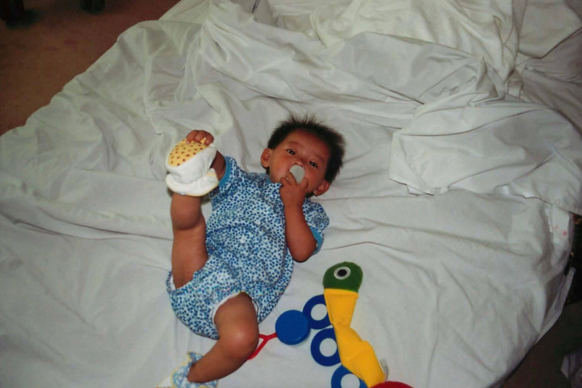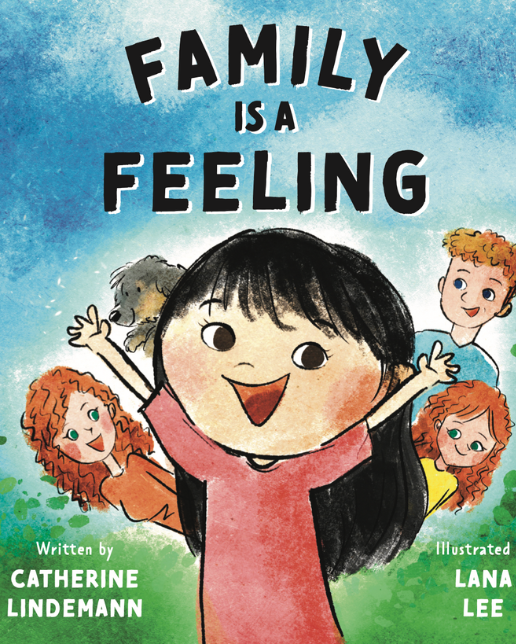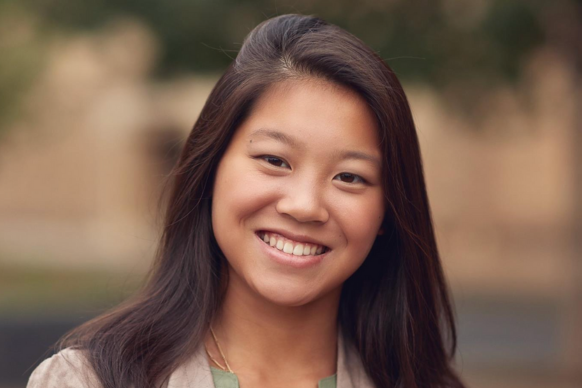In our Adoptee Spotlight Series, we highlight the unique stories and journeys of adopted adults. This month we are featuring Catherine Lindemann, author of the soon-to-be-published children’s book Family Is A Feeling. Catherine was adopted from China as an infant through Children’s Home and was raised in Minnesota. Read more about Catherine’s upcoming book and her personal search for identity and belonging below.
Congratulations on your soon-to-be-published children’s book Family Is A Feeling. Tell us more about your personal connection to adoption and why you felt inspired to write this book.
 My connection to adoption is simply that I was adopted from China at ten months old by a couple from Minnesota. From my understanding, before my parents adopted me, I was found outside a person’s house with a red note attached to my wrapped blanket. I was a few days old then, and was placed in an orphanage and foster care shortly thereafter.
My connection to adoption is simply that I was adopted from China at ten months old by a couple from Minnesota. From my understanding, before my parents adopted me, I was found outside a person’s house with a red note attached to my wrapped blanket. I was a few days old then, and was placed in an orphanage and foster care shortly thereafter.
Then, at ten months old, my mom, Lisa, and dad, Matt, adopted me. Both of my parents were amazing in more ways than one. They never treated me differently because I wasn’t genetically related to them. They always treated me as if I was always theirs.
My Mom used to say, “You were meant to be with us, and you are our daughter,” which helped me feel safe and secure growing up. However, as I aged and started making friends and attending school, most of my peers and even teachers were not expecting my parents to look the way they did. Given my appearance, I guess they thought my parents would have black hair, brown eyes, and be petite. But soon they all discovered that my parents were not only Caucasian, tall, with blue or green eyes, but one was ginger. To me, they were mom and dad, nothing more to it. However, to others, they saw that something was missing, or something was slightly off with this picture of my family. That’s when questions like, “Do you know your birth parents?”, “Why don’t you have red hair?” or “How can they be your mom and dad?” started begin asked. It stung.
 Granted, other comments were made and questions asked, but that is for another time. These questions persisted through elementary school and middle school. I eventually just answered with jokes or laughed it off. Some I would answer honestly, but I never let myself show my insecurity and discomfort around the matter because these questions just meant I never really belonged in the family that chose me. So as I aged, I pushed a lot of my cultural identity away and really tried to embrace other aspects of my American life to make myself feel like I belonged, until it got to a point where I did not know who I was because I was at odds with myself.
Granted, other comments were made and questions asked, but that is for another time. These questions persisted through elementary school and middle school. I eventually just answered with jokes or laughed it off. Some I would answer honestly, but I never let myself show my insecurity and discomfort around the matter because these questions just meant I never really belonged in the family that chose me. So as I aged, I pushed a lot of my cultural identity away and really tried to embrace other aspects of my American life to make myself feel like I belonged, until it got to a point where I did not know who I was because I was at odds with myself.
People saw me as Chinese; I saw myself as American. I saw myself as being a part of this fantastic and accepting family; others thought I didn’t belong or assumed I must feel like I was missing something. It took a lot of therapy, talks with my parents, advice from peers and mentors, and a dog, to finally come to terms with who I am and who I am meant to be. Ultimately, I wrote this book to share a different adoption story. The story of what comes after adoption sheds light on hardships adoptees might face in a world that tends to highlight differences rather than similarities. Then provide the comforting message that even though some families may not look the same, it’s how that family makes you feel that’s important.
What are some of the key themes of this book and what do you hope young readers and their families will take away from the book’s messages?
 I wrote this book with young readers and families in mind, and I also wrote it knowing this could reach a larger audience. Many families could be considered atypical in some way, shape, or form. That being said, I want these families and young readers to know that families come in all shapes and sizes, to be proud of who you are and your culture, and to know that love brings families together. Most importantly, I want my readers to know that they don’t have to change who they are to belong because your family loves you for exactly who you are.
I wrote this book with young readers and families in mind, and I also wrote it knowing this could reach a larger audience. Many families could be considered atypical in some way, shape, or form. That being said, I want these families and young readers to know that families come in all shapes and sizes, to be proud of who you are and your culture, and to know that love brings families together. Most importantly, I want my readers to know that they don’t have to change who they are to belong because your family loves you for exactly who you are.
Why do you think it’s so important for young adoptees to have access to books specifically about adoption?
Adoptees need books about adoption because finding others who can relate to such an event is hard. Even in my adoption group, we don’t talk about our adoption because it is a different story for everyone. However, books about adoption directed toward children can be so helpful in opening up conversations about adoption. In addition, it can give families and children a connecting point and provide a sense of general understanding and comfort. I can only speak from my own experience but reading books about adoption made me feel special and solidified that my family always wanted me and knew I was meant to be with them.
If you could share anything about your experience as an adoptee with prospective adoptive parents, what would you want them to know?
First, I want to let them know that they are enough and doing their best is all we could ever ask for. Second, acknowledging that we are different, but accepting us for who we are, is very important. Going further and expressing how our different backgrounds make the family stronger would also be beneficial. Third, you all are doing great.
What are some ways parents of adoptees can support their child or children?
 I can only speak on behalf of my experience and what I have found helpful, but what made me feel the most secure and comforted was my parents reminding me that they would accept me for me. I also found great comfort in listening to my parents tell me about my adoption and how they knew I was meant to be their daughter. They also let me choose how much or how little I wanted to talk about my adoption and about, my cultural heritage, and my feelings about being adopted. They never forced me to speak or participate in any specific activities; instead, they let me lead, and when I was ready to talk, so were they. Also, parents acknowledging physical differences but emphasizing the beauty around them and expressing blended families’ great qualities could help solidify an adoptee’s identity.
I can only speak on behalf of my experience and what I have found helpful, but what made me feel the most secure and comforted was my parents reminding me that they would accept me for me. I also found great comfort in listening to my parents tell me about my adoption and how they knew I was meant to be their daughter. They also let me choose how much or how little I wanted to talk about my adoption and about, my cultural heritage, and my feelings about being adopted. They never forced me to speak or participate in any specific activities; instead, they let me lead, and when I was ready to talk, so were they. Also, parents acknowledging physical differences but emphasizing the beauty around them and expressing blended families’ great qualities could help solidify an adoptee’s identity.
What is one message you would want to share with adoptee kids based on your own life experience?
 I want to let them know that their experiences are valid, and their emotions are valid. I would also want them to see that they are a part of that family because that family was missing a piece, and without them, their family would not be complete.
I want to let them know that their experiences are valid, and their emotions are valid. I would also want them to see that they are a part of that family because that family was missing a piece, and without them, their family would not be complete.
Adoption is a lifelong journey, and everyone’s experience is different. Is there anything special you do currently to connect with your birth culture as an adult?
I love to cook and bake, so I have been diving more into traditional Chinese cooking and baking. My partner and I try to cook one meal together each week since our jobs have demanding hours. So, we find a Chinese dish to cook and have a nice family meal together once a week. That is the beauty of having different cultural backgrounds—you can share parts of it with others and create new memories, family, friends, or even start new traditions.
When and where can folks buy your new book?
My book will launch this November in honor of National Adoption Month. It can be found on Amazon, Barnes and Noble, Kickstarter, and my publisher’s website, wiseink.com.
Want to learn more about Catherine and how you can support her work?
Visit catherinelindemannauthor.com for more information about how you can support the publication of her book, attend upcoming author events, and more.


